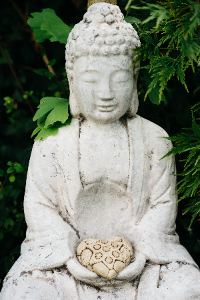Yoga and Buddhist Philosophy: The Brahmaviharas and Patanjali’s Yoga Sutra 1.33
by Katharine Bierce
Are you curious about yoga philosophy and connections to Buddhist meditation off the mat? Want to train your mind and not just your body? Keep reading!
The Yoga Sutras are an old Sanskrit text, compiled around between 500 BCE and 400 CE by Patanjali, in India who brought together knowledge about yoga from much older traditions. If you read the sutras, there’s a lot of seemingly obscure information about the yogic path of awakening, but for this article I want to focus on some very practical instructions on how to reduce your stress and live a happier life. In Sanskrit at least, they are short enough to be tweetable – things like “yoga is the cessation of the fluctuations of the mind” is a common one you might hear in a yoga class.
What’s so wonderful about yoga is that it’s not just physical: it is a complete philosophy that also encompasses the mental, emotional, and spiritual development towards being a more fully realized human being.
In the Samadhi Pada (which is one of the four sections of the Yoga Sutras), sutra number 33 is one of my favorites:
Maitri Karuna Muditopeksanam Sukha Duhka Punyapunya Visayanam Bhavantas Citta Prasadanam.
One of my favorite translations comes from T.K.V. Desikachar, who studied with the grandfather of modern yoga, Krishnamacharya. Desikachar explains thus in his book The Heart of Yoga:
“In daily life we see people who are happier than we are, people who are less happy. Some may be doing praiseworthy things and others causing problems. Whatever may be our usual attitude toward such people and their actions, if we can be pleased with others who are happier than ourselves, compassionate towards those who are unhappy, joyful with those doing praiseworthy things, and remain undisturbed by the errors of others, our mind will be very tranquil.”
In this way, the qualities of mind we want to cultivate are really WAYS OF SEEING, not a temporary state of mind (like a noun), but a verb – a practice to cultivate. The idea of practice as cultivating a way of seeing is also discussed in Rob Burbea’s excellent book Seeing That Frees. The idea is: we are always looking at the world through some sort of lens, like a person who wears glasses. Some days we have rose-colored glasses and everything seems great, and other days things may be more difficult; we can’t see as clearly because of our habits of mind. What this sutra is pointing to is that we can choose to put on a different set of glasses – by setting the intention to respond with loving-kindness, compassion, joy or equanimity depending on what happens, rather than our usual habitual reactions.
The Brahmaviharas or Four Immeasurables are in the Yoga Sutras
The 4 key words to note in Patanjali’s sutra 1.33 are as follows in the chart below. Sanskrit is the language in a lot of old yoga texts, like the Yoga Sutras. Pali is the language the Buddha spoke. In the Buddha’s Words is a great book that has an edited summary of the Buddha’s teachings in the Theravada tradition. Anyway, the same four qualities mentioned in Yoga Sutra 1.33 by Patanjali are also important qualities of mind that Brahmavihara meditation cultivates. The Brahmaviharas are the “divine abodes,” specifically, the divine abodes of the heart. You can’t think your way to enlightenment: you have to also cultivate “heart” qualities like kindness, compassion, joy, and equanimity to be a fully realized human being. The word for “awakened heart-mind” is bodhicitta, by the way: ultimately, Buddhism does not distinguish between cultivating the heart and mind, because they are really one and the same – there is one word for them: citta. Lastly, the four heart qualities are also known as the Four Immeasurables: things you can’t have too much of, no matter how full your closet is.
| Sanskrit | Pali | English |
| Maitri | Metta | Loving-kindness or goodwill (the wish to be happy) |
| Karuna | Karuna | Compassion (wishing to be free of suffering/stress) |
| Mudita | Mudita | Appreciative joy (happiness at the success of others) |
| Upeksha | Upekkha | Equanimity (meeting life with an “even keel”) |
A poem I wrote about the Brahmaviharas is here.
Instructions for Stress Management Off the Yoga Mat
If you watch any “reality” TV show, you’ll probably see people practicing the opposites or “far enemies” of these four heart qualities: hatred, cruelty, jealousy and clinging. While these opposite qualities can make for some amusing entertainment, they’re not a good recipe for a stress-free life.
So how does one cultivate these qualities in modern life? You can use the people around you to help wake you up. As one lojong or mind training slogan of the Mahayana Buddhist teachings from Atisha says, “Be grateful to everyone.” After all, it’s the people who piss us off the most, who can show us where we are stuck on the spiritual path!
With the Brahmaviharas in mind, you can use situations that might annoy you as reminders to practice emotional intelligence as follows:
- “Neutral” people: Practice loving-kindness, or wishing them well
- People who are unhappy: Practice compassion, or wishing them free from suffering
- People who are successful: Practice appreciation or joy for their good fortune
- When you can’t do anything about a situation: Practice equanimity
Or, to paraphrase the yoga sutra 1.33, cultivate loving-kindness towards the happy, compassion for people who are suffering, appreciative joy for those who are doing well and equanimity towards those who oppose our values.
The Heart Practice Instructions
Each of the Brahmaviharas mentioned in Yoga Sutra 1.33 has some phrases that you can use to cultivate these qualities, or ways of seeing. Just like a software program runs and takes input and creates output, you can replace unhealthy habits of mind like fear, anger, and jealousy by “running these programs” with a meditation practice. Another metaphor is: the mind is like a puppy that wants to run around and chew on the furniture. So, to train the puppy/mind, you give it something else to chew on, like a bone. The phrases to cultivate kindness, compassion, joy, and equanimity are like one of those Greenie bones that you can give a dog to clean its teeth while it chews!
Because different people resonate with different ways of practicing, here are a few different options for phrases for the Brahmaviharas. I have recorded a few guided meditations if you prefer listening to these as well.
Loving-kindness Meditation
One of the strongest antidotes to fear and anxiety is a way of seeing the world that is based on loving-kindness. The “Loving-All Method” describes this in more detail, but you can use these phrases anytime, especially if you’re the kind of person who thinks you’re not “good enough” – these are especially for you!
May I/you/we be safe.
May I/you/we be happy.
May I/you/we be healthy.
May I/you/we live with ease.
May I/you/we be filled with loving-kindness.
May I/you/we be well.
May I/you/we be peaceful and at ease.
May I/you/we be happy.
Compassion Meditation
The Dalai Lama says: If you want to be happy, practice compassion. If you want others to be happy, practice compassion.
May I/you/we be free from suffering and the causes of suffering.
May I/you/we be free from fear and danger.
May I/you/we be free from pain and sorrow.
May I/you/we find peace and healing.
Or:
May I/you/we find stillness in the midst of change.
May we find peace in the midst of struggle.
May we find softness in the midst of resistance.
May we rest in compassion.
Appreciative Joy Meditation
Appreciative or Sympathetic Joy is happiness at the happiness of another. It doesn’t cost you anything to rejoice in the good fortune of others, and is an antidote to jealousy. Is someone in your life doing well right now? How might your dog or cat feel when they see you? Did a colleague recently get a promotion? Try this practice to bring more joy into your life.
May your happiness increase.
May your good fortune continue.
Equanimity Meditation
Equanimity is the state of heart-mind that can meet reality with a sense of balance, poise, ease, etc. Even if you want something (or someone) to change, sometimes there are things beyond your control. Change is a constant, and it isn’t always what we like. Whatever it is, whether something is unpleasant or pleasant, or even neutral, it is bound to change because change is a constant. So we can’t hang on to pleasure or try to push away pain thinking that that reactivity will make us permanently happy. Equanimity practice is based on the recognition that the life someone has is a result of the effects of their choices: When you exercise regularly, you experience the benefits. Likewise, when you eat unhealthy foods, use unkind words, break promises, for example, you experience worse physical or mental health as a result.
May I accept myself as I am.
May I accept my life as it is.
May my heart-mind be at ease with the inner and outer changes of life.
Or:
All beings are owners of their actions, heirs to their actions. Their happiness or unhappiness depends upon their actions and not on my wishes for them.
You can do these practices as a complete meditation practice, while seated – or while waiting for an elevator, in line at a store, etc. Consider bringing in a few of these phrases the next time you notice yourself getting lost in worrying.
Note that each of these is a different flavor of the same underlying thing: unconditional love.
Stress Isn’t New, and Kindness Works
With the 24/7 news cycle, it is easy to get stuck in fear. However, the facts of change/impermanence and suffering have not changed since the time of the Buddha or Patanjali thousands of years ago. As neuroscience tells us, neurons that fire together, wire together. Repetition is the power behind building muscles at the gym as well as strengthening the heart-mind to respond to stressful situations with wisdom, rather than habitual reactivity that adds to the suffering in the world. This is not about making some external result happen; rather, by cultivating an open and caring heart-mind, we are better able to have an appropriate response to whatever arises in our lives.
“It is only with the heart that one can see rightly; what is essential is invisible to the eye.”
– Antoine de Saint-Exupéry
 Katharine first learned about meditation at an event with free food during college in Chicago in 2009. After attending classes with Shambhala, she started an almost-daily practice in 2012 while working in consulting in New York City. Her influences include Nikki Mirghafori, Pema Chödrön, Vipassana in the style of S.N. Goenka, Tucker Peck, Culadasa, Jeremy Graves, The Mind Illuminated, Rev. angel Kyodo williams, somatic meditation with Neil McKinlay and Norman Elizondo, and the insight meditation teachers at Spirit Rock. In March 2020, she completed a month-long meditation retreat, which is her seventh retreat of a week or more. Katharine works full time in technology marketing at a Fortune 100 company in San Francisco and also teaches yoga on evenings and weekends with Business Casual Yoga.
Katharine first learned about meditation at an event with free food during college in Chicago in 2009. After attending classes with Shambhala, she started an almost-daily practice in 2012 while working in consulting in New York City. Her influences include Nikki Mirghafori, Pema Chödrön, Vipassana in the style of S.N. Goenka, Tucker Peck, Culadasa, Jeremy Graves, The Mind Illuminated, Rev. angel Kyodo williams, somatic meditation with Neil McKinlay and Norman Elizondo, and the insight meditation teachers at Spirit Rock. In March 2020, she completed a month-long meditation retreat, which is her seventh retreat of a week or more. Katharine works full time in technology marketing at a Fortune 100 company in San Francisco and also teaches yoga on evenings and weekends with Business Casual Yoga.









